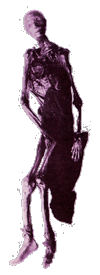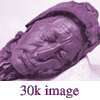
 Let's Meet The Bog People...
Let's Meet The Bog People...
by
William Clark

 Let's Meet The Bog People...
Let's Meet The Bog People...
by
William Clark
So, you've had a shitty day. Things could be worse...
Suppose that instead of sitting in front of a cathode ray tube basking in electronic emissions, a primitive denizen of the early Information-Age, you had lived instead in the Iron-Age, that you were the one who had drawn the black token, the blackened piece of bread, The Devoted One, the one who had been set aside to be feted with a last meal of cereal gruel (a repast, which when reconstituted and sampled by 20th. century archeologists was proclaimed worse than dying itself) and then ritually strangled with a woven plait, and - for good measure - savagely bludgeoned and throat-slashed, a blood sacrifice to the Mother Goddess on Winter Solstice; your naked, dead, or almost dead, body carried to the sacred bog (sites, which to this day often project an eerie je ne sais quoi) to be cast into the frigid, sepia water and then actually staked fast to the murky bottom with a lattice of saplings to protect the killers from your anguished revenge, held so effectively that you will not budge for all the centuries it takes for stratum after stratum of vegetation and silt to cover you and slowly solidify into the bog's peaty underbelly, a cold, acidic, anaerobic environment that custom-molds itself to your body, a time capsule that will preserve your body so remarkably that the itinerant peat cutters of modern times who come across it in the 17th., 18th., 19th. or 20th. centuries will sometimes mistake it for that of a recent murder victim (occasionally with comic or ironic results) - but not always, because bog bodies are not uncommon in northern Europe, and these same cutters or the police they've quickly summoned will just as quickly call in the scholars, who will take charge of the scene within hours, supervising the exhumation and exhaustively probing every aspect of your, now, rapidly decaying soma; burning your hair for the spectroscope; analyzing the contents of your stomach to identify the seeds, spores and pollen found there; sampling your tissues for parasites, disease, signs of trauma... not an altogether easy task when the corpus in question is over a thousand years old, and what might appear to be death trauma in the extreme could simply turn out as one of the myriad jokes of time; and then enbalming you with one the latest scientific methods, methods which, despite what one hears about their supposed inferiority to Egyptian methods, are actually most effective, and might well result with you on permanent public display in a museum somewhere - with no one to complain on your behalf about desecration, (no pressure group of Iron-Age Europeans to picket on your behalf, to demand the return of your remains as well as the rights for a casino...).
Yes, things could be worse. You could be a bog person.
 Hello,
I'm Tollund Man
Hello,
I'm Tollund Man The amazingly well-preserved and beatific-looking Tollund man is a veritable poster boy for human sacrifice. Tollund Man was discovered in 1950 by two men cutting peat, who were sure he must be a recent murder victim. Since the Tollund area in North Central Denmark is well-known for it's bog bodies, the police invited an official from the local museum to accompany them to the site. Within hours the estimable P.V. Glob, was at the scene. Glob had no doubt that the body dated from the Iron-Age.
Tollund Man had been buried naked except for a pointed skin cap and a hide belt. Around his neck was a nose woven from two leather thongs. Tollund Man was immediately excavated and transported to a museum, where it was determined that he was 2000 years old. After an examimation of the body, it was concluded that Tollund Man was probably hanged after a ritual meal of cereal gruel. In 1954, when the same meal was prepared for two archaelogists as part of a television show on BBC, one of the archaelogists proclaimed that whatever crime TM had committed, it would have been punishment enough to eat this gruel for the rest of his life.
Only Tollund Man's head was conserved, and remains to this day on display at the Silkeborg Museum, six miles from his place of death.
Two years afters after Tollund Man's discovery, peat cutters in Grauballe, Denmark, only eleven miles east of Tollund, discovered another bog body. The cutters immediately called in a local antiquarian who in turn called the University who called Glob. When Glob arrived the head of Grauballe man was exposed. Unlike Tollund Man, the expression on Grauballe Man's face was one of pain and terror. The body was excavated and taken to the Museum of Prehistory at Aarhus, which is now GM's home. Word of the discovery leaked out and crowds of people waited in line for hours to see the latest Bog Man.
Like Tollund Man, Grauballe Man had been consigned to the bog naked, his skin deeply tanned by the bog acids. Grauballe Man's hands and feet were so well preserved that the fingerprints could be easily read. Using a combination of Carbon-14 dating and a microscopic study of the pollen buried with him, Grauballe Man was dated to 310 A.D. plus or minus 100 years. His last meal had been very similar to Tollund Man's and had been eaten shortly before his death. His throat had been cut from ear to ear.
In the conservation of Grauballe Man, Glob decided to extend the natural processes that had begun in the bog. He constructed an oak trough and pit-tanned the body for over two years using over 1800 pounds of oak bark in the process. The results are on display at the Aarhus Museum.
In
1983, in the town of Lindow, thirty miles east of Liverpool, the severed
head of a woman was discovered by commercial peat cutters operating near
Lindow Moss, a massive and ancient bog. The police were called in. Since
the police had never been satisfied with the explanations of a local man
concerning the disappearance of his wife, who had vanished near the bog
some 20 years before, they decided to question their suspect one more time.
With the grisly evidence of his crime at hand, the man immediately confessed.
Alas for the hapless widower, the head in question was not that of his
wife. It belonged to a woman at least 1700 years older than his old lady.
A year later, a leg
was found. Unfortunately, the leg could not be traced to the exact area
in which it had originated; but the report led to the visit of archaeologist,
R.C. Turner, who quickly found a flap of skin emerging from a recently
excavated section of peat. The flap was part of the extremely well-preserved
body of an Iron-Age man who was painstakingly removed amidst a Brit media
circus. The tabloids dubbed the body "Pete Marsh."
Lindow
Man upon analysis proved to have been a healthy young man who had been
done in with almost unbelievable ferocity. First, he had been bludgeoned
three times, probably with an axe. Then he was savagely garrotted. The
axe blows or the garrot alone would have killed him, but, at the point
of death, someone also plunged a long thin blade deep into his throat,
probably to rapidly exsanguinate the body before he was symbolically drowned.
For a possible explanation
of this form of death check out the book by Ross and Robins below.
The Big Kahuna of bog is without question the aptly named P. V. Glob. Glob was the Director General of Museums and Antiquities for the State of Denmark. His book, The Bog People: Iron Age-Man Preserved, translated from the Danish, provides a detailed account of Glob's investigation of Tollund Man and other Danish bog bodies. Glob is also the author of The Mound People: Danish Bronze-Age Man Preserved. Throughout northern Europe, Bronze-Age man built elaborate burial mounds, a custom which for unknown reasons vanished in the Iron-Age. Two years after Tollund Man, Glob investigated Grauballe Man.
There are several good book on the Lindow Bodies. The Bog Man and the Archeology of People by Dan Boothwell is an excellent read. Boothwell, was one of the primary excavators of Lindow Man for the British Museum. The ultimate scientific account of the Lindow dig is Lindow Man: The Body in the Bog by Stead, Bourke and Brothwell. Another book on the Lindow bodies, also heavily academic, is Bog Bodies: New Discoveries and New Perspectives by Turner and Scaife. The Life and Death of a Druid Prince by Ross and Robins is a well-argued, but somewhat speculative theory about Lindow Man. Applying their expertise in Celtic lore and advanced forensic science, the authors closely analyze both the death wounds and the food found in the gut of Lindow Man. They then speculate that Lindow Man must have been a Druid and an exceptional sacrifice at a time of grave danger for the Celtic culture. To view another graphic of Lindow Man (or, if you have deep pockets, purchase a matted photo-polymer portrait of LM) check out The Holoshop.
For a general overview of the problems of deep time forensics try The Face of the Past by Paul Johnson. Johnson even discusses the shroud of Turin. People of the Wetlands: Bogs, Bodies and Lake-Dwellers provides good background on Iron-Age culture and a chapter on the Bog Bodies. And for a poetic elegy to Tollund Man, who better than nobel laureate Seamus Heaney, the bard of the bog
Quiz
1. A bog person's favorite movie director:
A. Alfred Hitchcock
B. Nicholas Ray
C. Peter Bogdanovitch
D. David Lynch2. A bog person's favorite baseball player of all time:
A. Babe Ruth
B. Mickey Mantle
C. Albert Belle
D. Wade Boggs3. A bog person's favorite board game:
A. Boggle
B. Monopoly
C. Risk
D. Clue4. What scares a bog person most:
A. A ghost
B. A banshee
C. A vampire
D. A bogey man
| Table of Contents |
| Tension | February/March 1997 |
 |